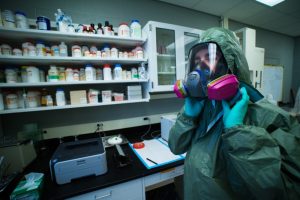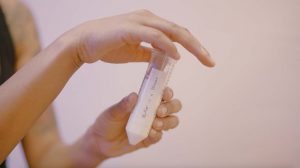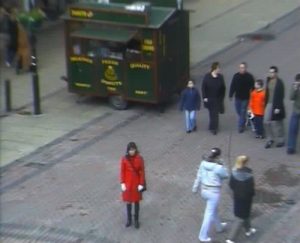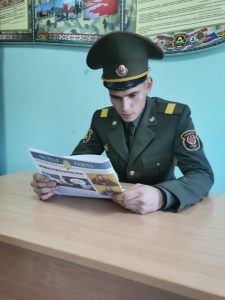Last week i flew to one of my favourite cities, Liverpool, to visit the Sk-interfaces exhibition at the FACT art center. The show, curated by Jens Hauser, explores, materially and metaphorically, the concept of skin as a technological interface.
A controversial new exhibition on display in Liverpool showcases real skin tissue in sculptures wrote the BBC news website. Yet every single person i spoke with during the 2 days i spent in the city didn’t seem to find the show controversial. Interesting, surprising, fascinating, challenging, thought-provoking, worth bringing my mum, etc. That’s what i heard but no one i talked to seemed overly shocked nor disturbed.
There is material to cause quite a stir in sk-interfaces but Liverpudlians seemed to be more concerned by the issues brought to light by the artists than by the potentially seditious or “freaky” character of the works on show.
I’ll start the blog visit of this multi-disciplinary exhibition by walking to the second floor of FACT.
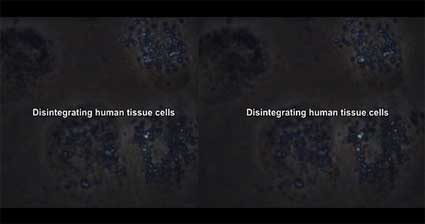 Critical Art Ensemble, Immolation. Image courtesy of the artists
Critical Art Ensemble, Immolation. Image courtesy of the artists
Immolation is a video installation concerned with the subject of the use of incendiary weapons on civilians after the Geneva Convention and the Protocol on Prohibitions or Restrictions on the Use of Incendiary Weapons of 1980. The USA have refused to sign the convention and they make regular use of firebombs in the Middle East. Not because these bombs are the most efficient (they are not), but because they act as moral crushers, tapping on people’s visceral fear of being burned alive.
This video chronicles the major war crimes of the United States involving these weapons on a ( macro) landscape level, and contrasts it with the damage done to the body on the (micro) cellular level.
To accomplish this task, the Critical Art Ensemble (a collective of tactical media practitioners who explore the intersections between art, critical theory, technology, and political activism) grew human tissue at SymbioticA last year, and using high-end microscopy shot the micro footage of skin cells dying by either exploding or imploding. In parallel, CAE shows film footage of present and past wars that have used immolation against civilian targets as a strategic choice for the sole purpose of terrorizing entire populations.
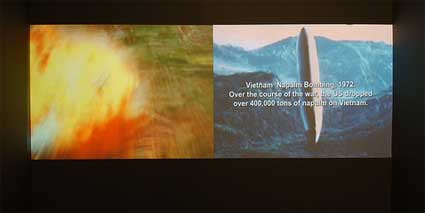 Critical Art Ensemble, Immolation
Critical Art Ensemble, Immolation
The result is a video where war crime are shown at both the micro and macro level but which skips the human level. Yet you still manage to view your own body in the narrative. The video is made even more unsettling by the absence of sound, it’s just silence and destruction.
The goal is to provide a different way of imaging, viewing, and interpreting the human costs of these war crimes, in contrast to the barrage of media imagery to which we have become so desensitised. The video portrays what CAE calls an “ecology of crime.”
CAE felt that as long as warfare would be at the center of the Bush agenda, they had to come up with new connections and find venues to show their work (since the arrest of Steve Kurtz some US administrations are feeling the pressure).
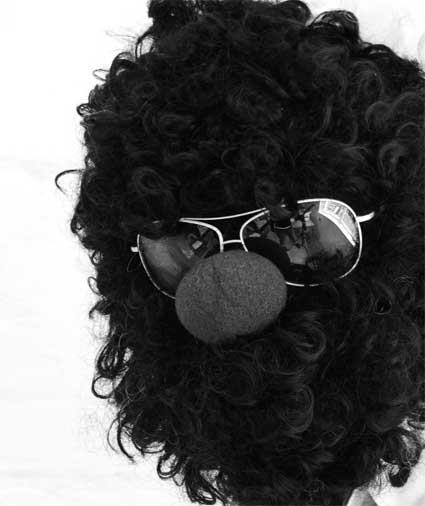
Right next to Immolation, is Truth Serum, a work that responds to the lawsuit against Steve Kurtz and their persecution of Critical Art Ensemble in the USA, which marks an ever-increasing creep of the security state into the nervous system of culture.
For Truth Serum, The Office of Experiments, initiated by Neal White, follows research on serums used historically by official authorities in interrogation processes as a means to obtain information without using torture. The effects of truth drugs were first examined in the 1920’s, and heavily used by the CIA during the Cold War. The present artwork echoes the debate around art’s freedom in the fear and increasing security regime that has emerged after 9/11, while drawing on the cultural history of so-called truth drugs and recent discussions about their use in the interrogation of suspected terrorists.
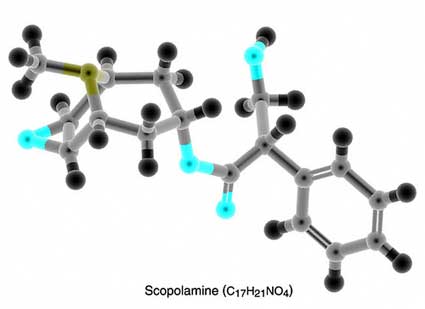 Scopolamine, an ingredient used in truth serums (image courtesy of Neil White)
Scopolamine, an ingredient used in truth serums (image courtesy of Neil White)
The use of truth serums is actually illegal but after 9/11 there have been talks (mostly in the press) of using the method again during interrogations by the FBI and the CIA, even though truth serums are more an art than a science.
The installation at FACT combines a space concealed behind a white door and a series of video works that reflect on the aesthetics of terrorist messages, using a dark clown as an anonymous spokesman who reflects on the possibility of carrying out mass self-experimentation with truth drugs as a form of self-defence.
On 29 March 2008, volunteers will be able to participate to the performative part of the Truth Serum installation in support of freedom from artistic censorship.
In a central (and still secret) Liverpool location, participants will willingly submit themselves to a short psychological experiment based on substantiating Truth lasting around 10 minutes. The aim is to probe an atmosphere of paranoia spreading since 9/11.
More information to participate.
My pictures and FACT pictures.
sk-interfaces is on view until March 30 and launches FACT’s Human Futures programme which includes 3 sections – My Body (SK-Interfaces), My Mind and My World, each one hosting a major exhibition, conference and research focus. You can follow its development through Human Futures blog.
Related: They make art not bioterrorism, Jens Hauser’s presentation in Aix en Provence (part 1 and 2.)

